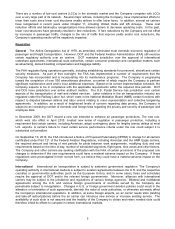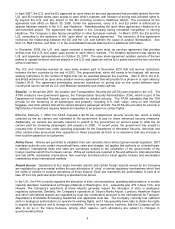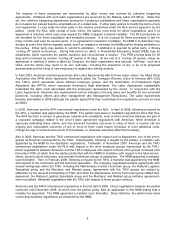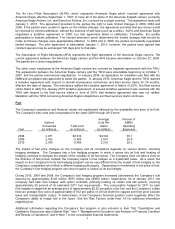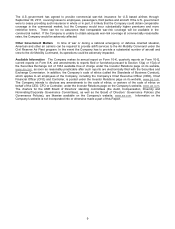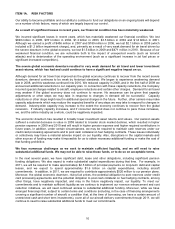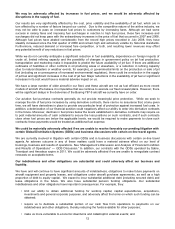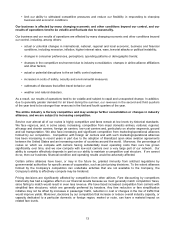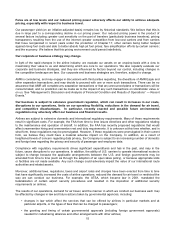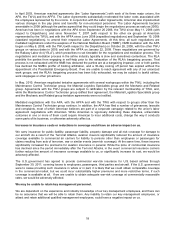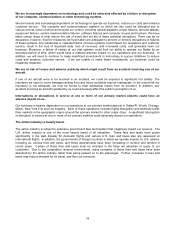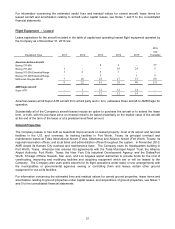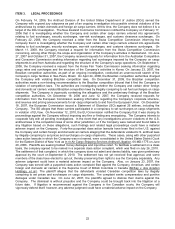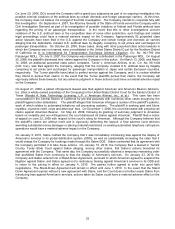American Airlines 2010 Annual Report Download - page 16
Download and view the complete annual report
Please find page 16 of the 2010 American Airlines annual report below. You can navigate through the pages in the report by either clicking on the pages listed below, or by using the keyword search tool below to find specific information within the annual report.
13
•
limit our ability to withstand competitive pressures and reduce our flexibility in responding to changing
business and economic conditions.
Our business is affected by many changing economic and other conditions beyond our control, and our
results of operations tend to be volatile and fluctuate due to seasonality.
Our business and our results of operations are affected by many changing economic and other conditions beyond
our control, including, among others:
•
actual or potential changes in international, national, regional and local economic, business and financial
conditions, including recession, inflation, higher interest rates, wars, terrorist attacks or political instability;
•
changes in consumer preferences, perceptions, spending patterns or demographic trends;
•
changes in the competitive environment due to industry consolidation, changes in airline alliance affiliations
and other factors;
•
actual or potential disruptions to the air traffic control systems;
•
increases in costs of safety, security and environmental measures;
•
outbreaks of diseases that affect travel behavior; and
•
weather and natural disasters.
As a result, our results of operations tend to be volatile and subject to rapid and unexpected change. In addition,
due to generally greater demand for air travel during the summer, our revenues in the second and third quarters
of the year tend to be stronger than revenues in the first and fourth quarters of the year.
The airline industry is fiercely competitive and may undergo further consolidation or changes in industry
alliances, and we are subject to increasing competition.
Service over almost all of our routes is highly competitive and fares remain at low levels by historical standards.
We face vigorous, and, in some cases, increasing, competition from major domestic airlines, national, regional,
all-cargo and charter carriers, foreign air carriers, low-cost carriers and, particularly on shorter segments, ground
and rail transportation. We also face increasing and significant competition from marketing/operational alliances
formed by our competitors. Competition with foreign air carriers and with such marketing/operational alliances
has been increasing in recent years in part due to the adoption of liberalized open skies aviation agreements
between the United States and an increasing number of countries around the world. Moreover, the percentage of
routes on which we compete with carriers having substantially lower operating costs than ours has grown
significantly over time, and we now compete with low-cost carriers over a very large part of our network. Our
ability to compete effectively depends in part on our ability to maintain a competitive cost structure. If we cannot
do so, then our business, financial condition and operating results would be adversely affected.
Certain airline alliances have been, or may in the future be, granted immunity from antitrust regulations by
governmental authorities for specific areas of cooperation, such as joint pricing decisions. To the extent alliances
formed by the Company’s competitors can undertake activities that are not available to the Company, the
Company’s ability to effectively compete may be hindered.
Pricing decisions are significantly affected by competition from other airlines. Fare discounting by competitors
historically has had a negative effect on our financial results because we must generally match competitors’ fares,
since failing to match would result in even less revenue. We have faced increased competition from carriers with
simplified fare structures, which are generally preferred by travelers. Any fare reduction or fare simplification
initiative may not be offset by increases in passenger traffic, reduction in cost or changes in the mix of traffic that
would improve yields. Moreover, decisions by our competitors that increase or reduce overall industry capacity, or
capacity dedicated to a particular domestic or foreign region, market or route, can have a material impact on
related fare levels.


